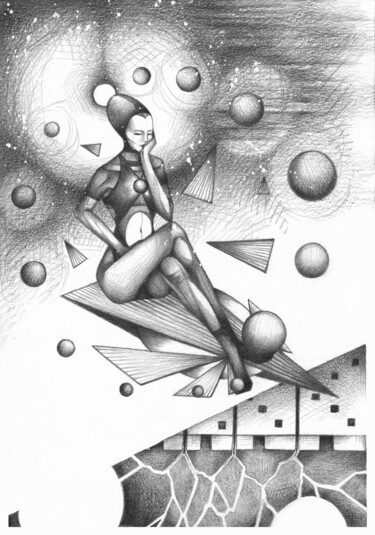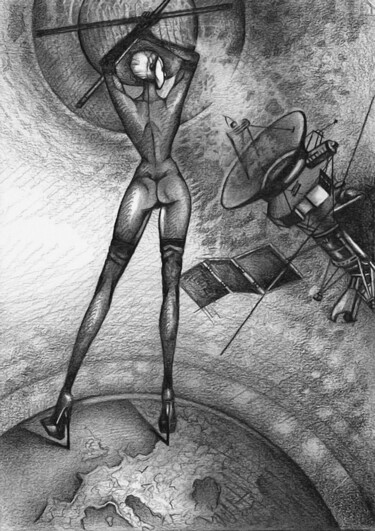
214 판매용 원본 그림 및 일러스트레이션:
판매용 원본 드로잉을(를) 찾고 계십니까?
현대 미술, 거리 미술, 추상 미술, 구상 미술, 풍경, 초상화, 삶의 장면, 누드, 연필, 잉크, 목탄, 파스텔 등 모든 스타일과 모든 드로잉 기법을 살펴보세요. 360만 개 이상의 현대 미술 작품을 통해 20년 동안 당신의 아름다움을 발견하거나 획득하세요! 예술적 그림의 관점에서 세계 참조. 전 세계의 현대 작가들의 작품을 찾아 품격 있는 인테리어를 완성해보세요! 단순한 예술 애호가 또는 확인된 수집가? 장식을 진정으로 향상시킬 마음에 드는 그림이나 스케치를 찾으십시오. ArtMajeur는 세계 최고의 현대 예술가들의 독창적인 작품, 한정판 및 예술 판화를 제공합니다. ArtMajeur에서 그림은 미술 시장 애호가와 전문가에 의해 선택됩니다. 트렌디하고 수상 경력에 빛나는 유명 디자이너의 원본 작품과 현대 미술 분야의 새로운 떠오르는 스타를 선택하여 온라인으로 아트 드로잉을 구매하는 과정을 안내하고 도와드립니다.
Discover contemporary Technology Drawings on ArtMajeur
Contemporary Technology Drawings are a fascinating genre of original artwork that is gaining popularity in the modern world. They are created using a variety of supports and materials, including digital tablets, stylus pens, and specialized software. These works of art are unique in that they combine the precision and accuracy of digital technology with the creative vision of the artist.

©2015 Götz Wiedenroth
Origins and History
Contemporary Technology Drawings emerged in the late 20th century as artists began exploring the relationship between technology and art. This movement was influenced by the rise of digital media and the computerization of design processes, which allowed for greater precision and control over artistic output.

©2023 Hugh Kerr
Evolutions of theses works in the contemporary art market
Contemporary Technology Drawings have experienced a significant evolution in recent years. With the advent of digital technology, artists have been able to explore new ways of creating art, which has led to the emergence of new forms of drawing. These new forms range from computer-generated graphics to interactive installations and augmented reality experiences. The importance of these drawings in the contemporary art market cannot be overstated.

©2025 Aurélie Sarrazin
Related Famous Artists
Contemporary technology drawings have become increasingly popular over the last few years, and several artists have made a name for themselves in this field. One of the most well-known is Daniel Rozin, whose interactive installations use technology to create mesmerizing works that respond to the movements of the viewer. His "PomPom Mirror" is particularly noteworthy, as it uses 928 faux fur puffs to create a stunning, animated reflection.
Another artist who has gained recognition for her work with technology is Camille Utterback. Her interactive installations often involve projections and sensors that respond to the movements of the viewer, creating a unique and immersive experience. Her "Text Rain" piece, in which falling letters respond to the movements of the viewer, has become a classic of the genre.
A third artist who has made a mark in the world of contemporary technology drawings is Rafael Lozano-Hemmer. His work often involves large-scale installations that use technology to create a dialogue between the viewer and the artwork. His "Pulse Room" installation, for example, uses the heartbeats of visitors to control the lighting in the room, creating a unique and intimate experience.
Other notable artists in this field include Golan Levin, whose work often involves the intersection of technology and biology, and Zach Lieberman, whose interactive installations blur the line between the virtual and the physical world. Overall, the world of contemporary technology drawings is a vibrant and exciting one, with artists pushing the boundaries of what is possible with new technologies and techniques.

©2024 Nega
Notable contemporary Technology Drawings
"Untitled (Google Maps)" by Simon Weckert, 2020, is a performance artwork that involved the artist pulling a wagon full of smartphones through the streets of Berlin to create fake traffic jams on Google Maps. This work comments on our over-reliance on technology and how it can be manipulated.
"Trojan Room Coffee Pot" by Quentin Stafford-Fraser and Paul Jardetzky, 1991, is a historic artwork that depicts the first webcam ever created. The webcam was set up to monitor the coffee pot in a break room at the University of Cambridge. This artwork revolutionized the way we communicate and access information.
"Can You Hear Me?" by Rafael Lozano-Hemmer, 2002, is an interactive artwork that allows visitors to speak into a microphone and have their voice converted into a beam of light, which is projected onto a building. This work explores the relationship between technology, communication, and public space.
"The Clock" by Christian Marclay, 2010, is a video installation that features a 24-hour montage of film and television clips that depict or reference time. The work is synchronized with the actual time and is a commentary on the ways in which we perceive and measure time in our daily lives.
"Hello World!" by Chris Milk, 2011, is an interactive installation that features a robotic arm that writes "Hello World!" in sand. The arm is controlled by a computer algorithm that responds to social media messages. This work explores the relationship between technology, communication, and the natural world.
"Selfie Harm" by Rankin, 2019, is a photography project that features a series of portraits of young people who have been digitally altered to look like they have undergone plastic surgery. The work comments on the pressure that social media and technology place on individuals to conform to unrealistic beauty standards.
"Data-Drive" by Refik Anadol, 2019, is an art installation that uses artificial intelligence to generate abstract visuals based on data collected from the Los Angeles Philharmonic’s archives. This work explores the intersection of technology, data, and creativity.


Rafael Castillo Guillén
종이의 잉크 | 19.7x27.6 in

José Ignacio Gianola
종이의 볼펜 | 19.7x11.4 in

O. Soniart
종이의 흑연 | 11.7x8.3 in

Nolan Trace
종이의 마커 | 9.8x9.8 in































